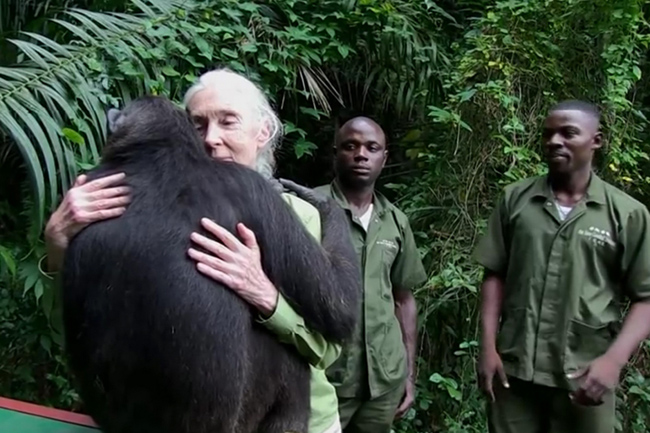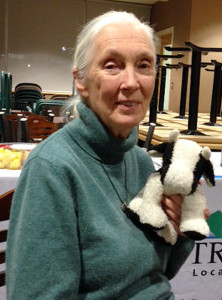
The bright lights that shone onto Jane Goodall’s face as she spoke at Thompson Rivers University Monday night took their toll.
By the time Goodall asked for the lights to be dimmed so she could field questions from the audience after more than an hour of telling stories of her life and urging everyone to do what they can to make the world better, her eyelids were growing heavy and her responses less energetic.
Given that she was a week and a half away from her 80th birthday on April 3, it’s not surprising that her 300-days-a-year-on-tour schedule might have snuck up on her.
Whatever the reason, she seemed tired as she took a few moments after the end of her presentation to speak to local media, including me in my dual role as reporter for the Armchair Mayor News and as blogger for The Animal Reporter.
Meeting someone you hold in high esteem is far more daunting than speaking with someone who famous but not a big deal in your world. For me, Goodall was a big deal. Meeting that petite 79-year-old primatologist and animal activist was more intimidating than interviewing any politician or even Queen Elizabeth and Prince Philip (whom I met decades ago).
So when it came to asking questions, my mind went blank. I babbled, I asked things that were obvious.
How’s your health? I am healthy, I have good genes from my dad’s side. Why haven’t you just retired to your home? My sister and I share the home we grew up in. How could I retire?
I did glean one insight. She didn’t get to all her messages in her TRU speech — the lights wore her down and distracted her from hitting all her speaking points. She had planned on talking about factory farming and showed me the black and white stuffed cow she usually uses for that topic.

Commercial farming is bad in Goodall’s books. Not surprising. It leads to deforestation, excess methane production, overuse of antibiotics that escape into the environment and cause a list of other health issues and, of course, animal suffering and abuse.
When she’s not on the road preaching hope and appealing for support for her Jane Goodall Institute’s efforts to rescue chimpanzees or her Roots and Shoots groups that encourage youth to do all kinds of good things, she takes a short break at the family home in England or returns to Africa where her studies began in 1960.
A couple of times a year, she goes back to the Gombe park where she first started watching chimpanzees and made discoveries that scientists hadn’t known, like the fact chimps use tools such as sticks to fish termites out of holes. Or that they are capable of a range of expressions from kissing and embracing to swaggering and throwing rocks at others.
As a child, Goodall exhibited behaviour that foreshadowed her future. At four and a half, she wondered how eggs got out of chickens. She tried following a hen into a coop, but the bird became flustered and wouldn’t settle down. So Goodall set herself up in an empty coop, hiding under the hay, and waited.
She waited so long, it was getting dark outside and her family didn’t know where she was.
She made her chicken biology observation and ran in to share her findings. Her mother, instead of being angry at her missing-in-action child, noted the shine of discovery in her daughter’s eyes and her eager words.
“Isn’t that the story of a little scientist?” Goodall quipped to the audience of more than 1,000 people gathered at Thompson Rivers University’s Campus Activity Centre.
Goodall grew up in Second World War London in a family that had little money. While she was a voracious reader, she often had to rely on libraries and used-book stores to feed her literary appetite.
At age 10, she scraped together enough money to buy Tarzan of the Apes — a book set in Africa that included lots of animals.
“Of course I fell in love with Tarzan,” she confessed, then quipped a line you know she’s used before: “He married the wrong Jane.”
While Goodall aspired to travel to Africa and write books about animals, the attitude at that time was for women to fall into traditional roles: housewife, mother, teacher, secretary, nurse.
She eventually did get to Africa when she was 23. A friend with a family home in Kenya invited her out. Goodall had her visit, then found work with renowned palaeontologist Louis Leakey. He started Goodall on her study of chimpanzees.
“We didn’t know at the time how similar humans and chimpanzees were.”
In 1986, Goodall was at a conference of scientists who study apes and was shocked to see just how much the animals’ habitat was disappearing and how chimps housed in cramped cages were being used in lab experiments. That’s when she put her observations aside to become an activist.
“Can it be right to keep them in conditions like that?” she said about the cages.
Since then, she has been travelling 300 days a year raising awareness about the plight of the apes and creating organizations to take action.
Her goal these days is to create hope among the young so they, too, are inspired to do something about the environment, about declining animal species and about humans living in poverty who turn to desperate measures to feed themselves and their families.
“If our young people lose hope, then there’s little hope for the future,” she said.
“There are so many problems facing the planet, it’s hard to know where to begin.”
Her advice is to begin anywhere. Grow an organic garden, work in a soup kitchen, raise money to save wildlife.
Goodall’s own reward for her decades of dedication came, she said, six months ago. She helped in the release of an orphaned chimpanzee named Wounda, which means close to death. Wounda did almost die, but was given a life-saving blood transfusion at the Congo Tchimpounga Chimpanzee Sanctuary.
Wounda’s release to a sanctuary island was caught on film. It shows the chimpanzee getting out of her travel crate, standing on top of it, then leaning over and hugging Goodall.
“That was the most moving thing in my life so far,” she said.
She is also thanked, sometimes for her work involving apes, but most often for something else.
“If I’m thanked for anything, I’m thanked for giving hope,” she said. “Surely in the end, we have to win.”
